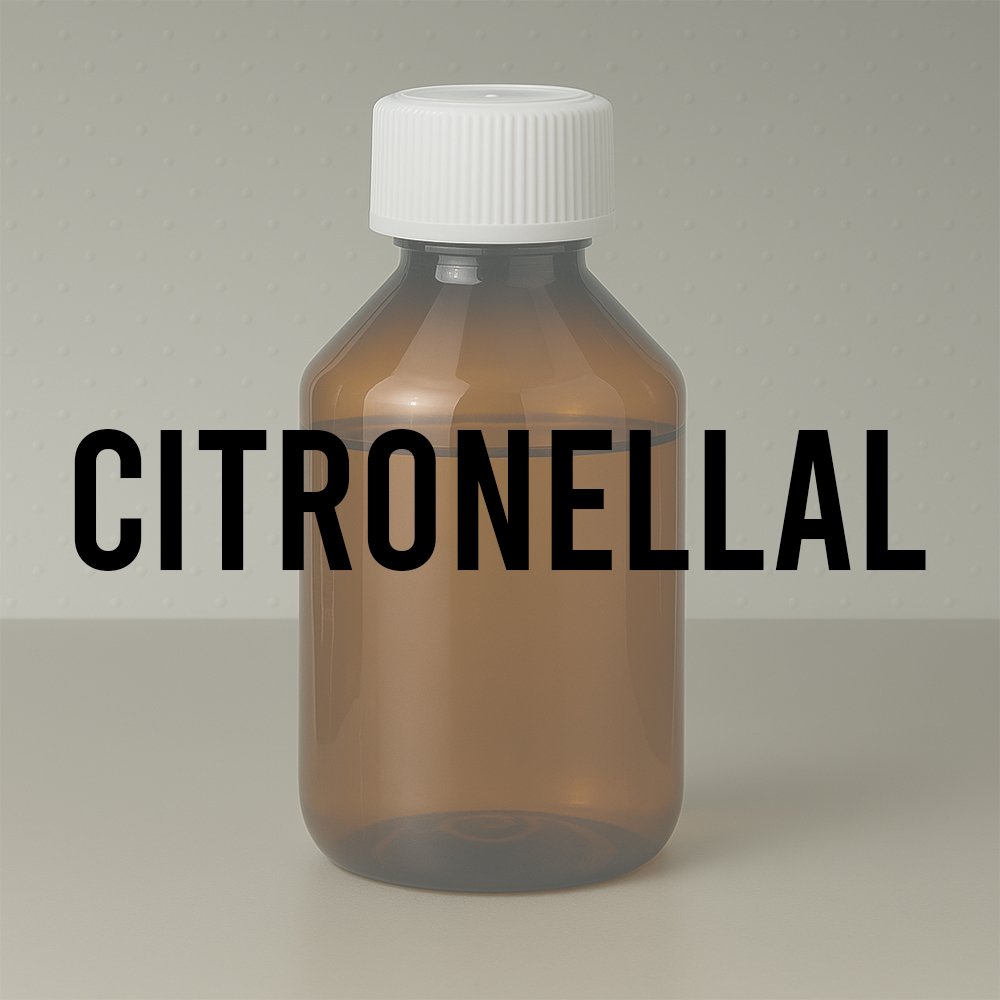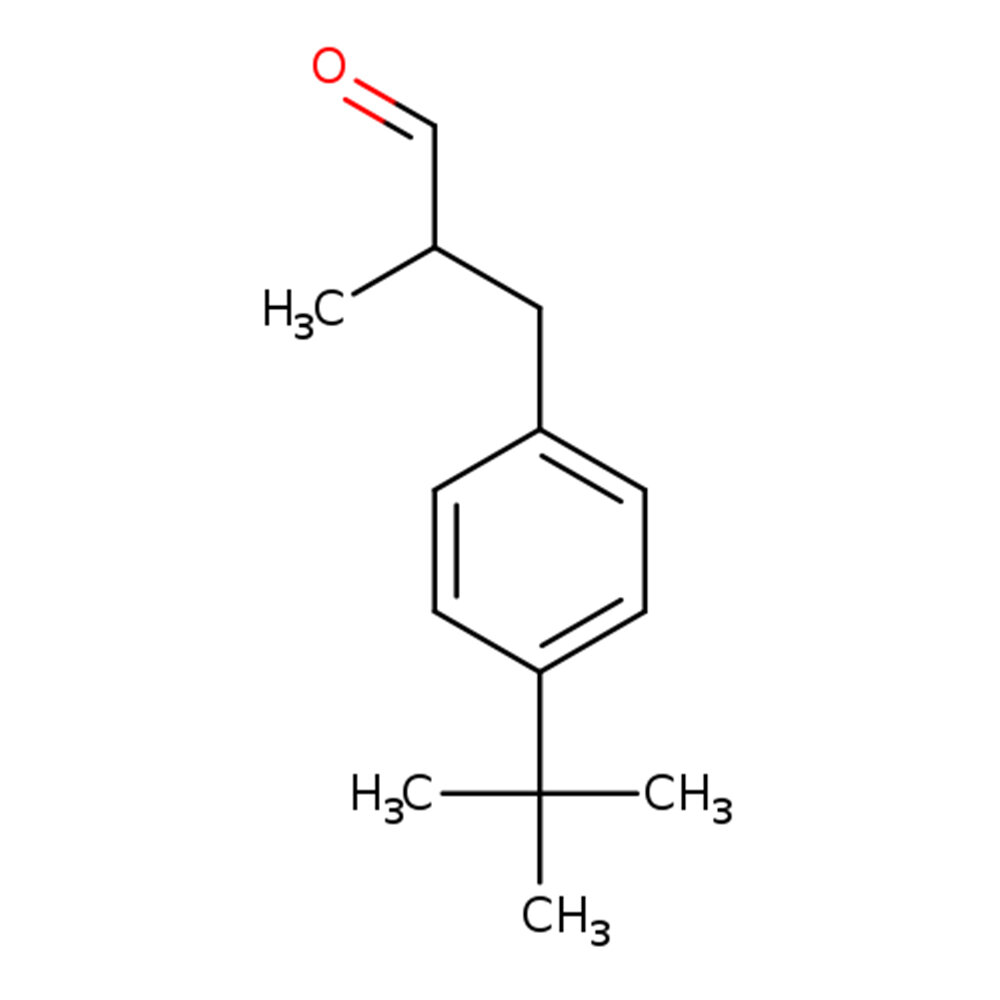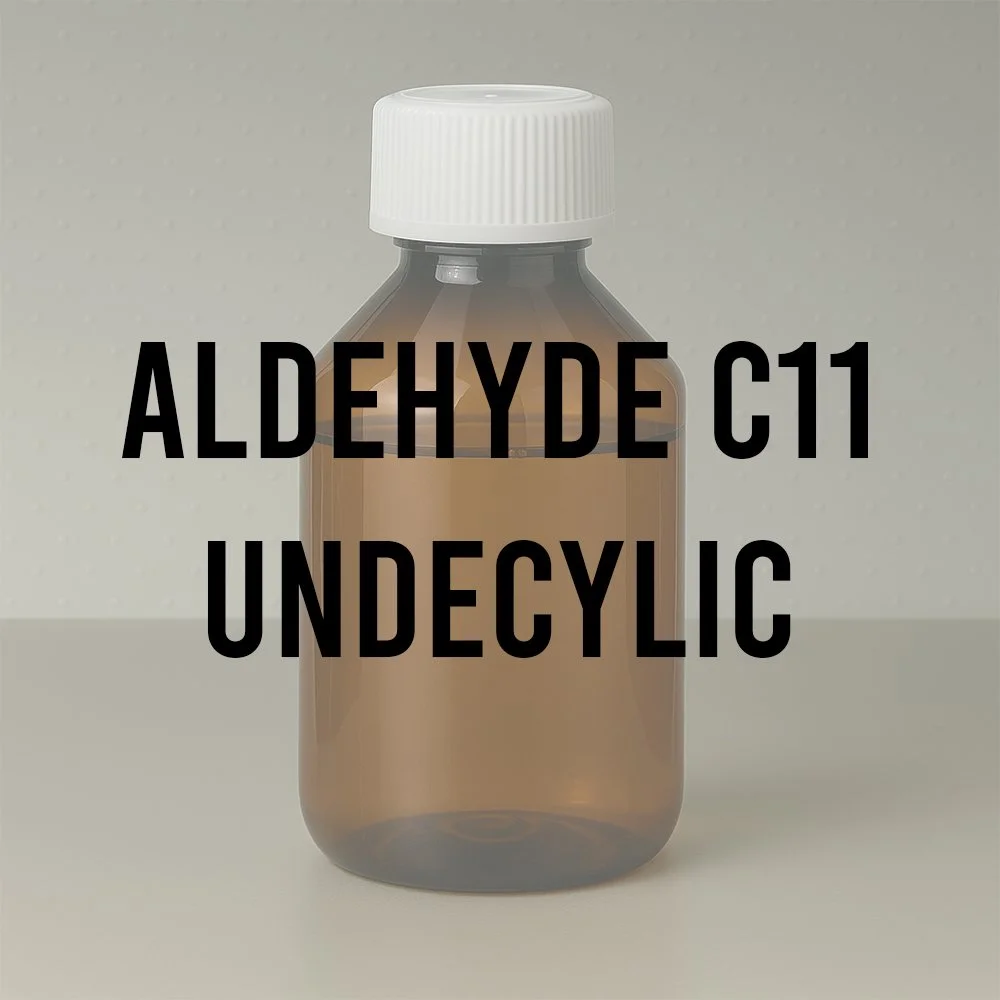Technical Ingredient Overview
🏭 Manufacturer —
🔎 Chemical Name — 3,7-Dimethyloct-6-en-1-al
🧪 Synonyms — Citronellal, 3,7-Dimethyl-6-octen-1-al, β-Citronellal
📂 CAS Number — 106-23-0
📘 FEMA Number — 2307
⚖️ Molecular Weight — 154.25 g/mol
📝 Odor Type — Aldehydic, Citrus, Fresh
📈 Odor Strength — Medium to Strong
👃🏼 Odor Profile — Fresh, lemony-citrus with green, aldehydic facets and subtle floral undertones
⚗️ Uses — Citrus accords, rose compositions, lemongrass reconstructions, aldehydic florals
🧴 Appearance — Colorless to pale yellow liquid with characteristic citrus odor
What is Citronellal?
Citronellal is a monoterpenoid aldehyde that belongs to the acyclic terpene family, characterized by its distinctive fresh, lemony-citrus aroma profile. As a synthetic fragrance ingredient, it serves as one of the fundamental building blocks in modern perfumery, particularly valued for its ability to impart brightness, freshness, and lift to fragrance compositions (Arctander, 1969). The molecule features an unsaturated carbon chain with an aldehyde functional group, which contributes to its high volatility and characteristic sharp, green-citrus character.
Chemically, citronellal exists as a mixture of stereoisomers, with the racemic form being most commonly used in commercial applications. This structural characteristic allows it to exhibit slightly different olfactory nuances depending on the specific isomeric composition, though both forms contribute to the overall fresh, citrus profile that defines this material.
Historical Background
The discovery and development of citronellal as a fragrance ingredient traces back to the early 20th century when advances in terpene chemistry enabled the isolation and synthesis of various monoterpene compounds. Originally identified as a component of citronella oil (Cymbopogon nardus and C. winterianus), citronellal was first synthesized commercially in the 1920s as part of the broader development of synthetic terpene aldehydes (Sell, 2006).
The industrial synthesis of citronellal became economically viable through the development of the "citral route," where myrcene serves as a key intermediate. This synthetic pathway, perfected in the 1950s and 1960s, allowed for large-scale production and made citronellal an accessible ingredient for both fine fragrance and functional applications. The material gained particular prominence during the aldehydic floral trend of the mid-20th century, where its fresh, lifting character proved essential in creating the signature sparkle associated with this fragrance category.
Firmenich and other major fragrance houses contributed significantly to refining the synthesis and purification processes, establishing citronellal as a standard component in the perfumer's palette by the 1970s. Its versatility in both citrus and floral accords secured its position as an indispensable material in contemporary perfumery.
Olfactory Profile
Scent Family: Aldehydic-Citrus with secondary floral characteristics
Main Descriptors: The primary olfactory impression of citronellal is characterized by a bright, sparkling lemon-like freshness with distinct aldehydic sharpness. The initial impact delivers clean, zesty citrus notes reminiscent of fresh lemon peel, accompanied by green, slightly metallic aldehydic facets. As the material develops, subtle floral undertones emerge, particularly rose-like nuances that bridge its citrus character with floral applications.
Intensity: Citronellal exhibits medium to strong odor intensity (rated 7/10), with excellent diffusion properties that make it highly noticeable even at low concentrations. Its impact is immediate and penetrating, contributing significant lift and sparkle to fragrance compositions.
Tenacity: Despite its aldehydic volatility, citronellal demonstrates moderate persistence, typically lasting 2-4 hours on a smelling strip. In formulation, it functions primarily as a top note material, though its influence can extend into the early heart development of a fragrance.
Volatility: High volatility classification with rapid evaporation rate, making it ideal for creating immediate olfactory impact. The material's vapor pressure characteristics place it firmly in the top note category, with peak diffusion occurring within the first 15-30 minutes of application.
Fixative Role: While citronellal itself requires fixation rather than providing it, its interaction with rose alcohols (geraniol, citronellol) and certain musks can enhance the overall longevity of citrus-floral accords.
Applications in Fine Fragrance
Citronellal occupies a crucial position in fine fragrance composition, serving multiple functional roles across various fragrance families. In citrus compositions, it provides the characteristic bright, sparkling quality that defines high-quality lemon and bergamot accords. Its aldehydic character contributes the "fizz" that elevates simple citrus oils into sophisticated citrus compositions suitable for fine perfumery applications.
Within floral fragrances, particularly rose compositions, citronellal serves as an essential brightening agent. Its ability to enhance the freshness of rose accords while maintaining compatibility with key rose materials makes it invaluable in both classic and modern rose interpretations. The material shows exceptional synergy with Hydroxycitronellal, creating lily-of-the-valley effects that add complexity to floral bouquets.
The aldehydic floral category represents perhaps citronellal's most significant application area. In compositions inspired by classic aldehydic florals, citronellal provides the essential "sparkle" that characterizes this fragrance style. Its interaction with fatty aldehydes (C10, C11, C12) creates the signature aldehydic lift while its floral undertones prevent the composition from becoming overly sharp or metallic.
Citronellal also finds application in lemongrass reconstructions and herbal-citrus compositions, where its green facets complement other terpene materials. Modern niche fragrances frequently employ citronellal in unexpected combinations, utilizing its brightness to illuminate woody or oriental bases.
Performance in Formula
In fragrance formulation, citronellal demonstrates excellent blending characteristics with both citrus and floral materials. Its behavior in alcoholic solutions is stable, showing good clarity and color stability when properly stored. The material exhibits moderate solubility in ethanol and excellent compatibility with other volatile components commonly used in top note constructions.
The diffusion characteristics of citronellal make it particularly effective in creating radiance and lift in fragrance compositions. Its high vapor pressure ensures immediate impact, while its molecular weight allows for sustained evaporation that maintains presence throughout the early stages of fragrance development. This diffusion profile makes it especially valuable in fine fragrance applications where immediate impression is crucial.
Compatibility studies indicate excellent behavior when blended with Geraniol, Citronellol, and Linalyl Acetate, creating synergistic effects that enhance the overall freshness and complexity of floral compositions. The material shows particular affinity for rose oxide and phenylethyl alcohol, contributing to sophisticated rose interpretations.
Citronellal's aldehyde functionality requires careful consideration regarding pH sensitivity and potential interactions with nucleophilic fragrance components. Proper formulation practices include avoiding extended exposure to alkaline conditions and ensuring adequate antioxidant protection in finished products.
Industrial & Technical Uses
Beyond fine fragrance applications, citronellal serves important functions in various industrial sectors. In the flavor industry, its FEMA GRAS status (FEMA 2307) permits use in citrus flavorings, particularly lemon and lime profiles for beverages and confectionery applications. Typical usage levels range from 1-5 ppm in finished food products.
The material functions as a key intermediate in the synthesis of other important fragrance compounds, particularly in the production of hydroxycitronellal through controlled oxidation reactions. This derivative relationship makes citronellal valuable not only as a finished fragrance ingredient but as a synthetic building block for more complex molecules.
In functional fragrance applications, citronellal contributes to household products, personal care formulations, and air care products where fresh, clean impressions are desired. Its stability in various formulation matrices and compatibility with surfactant systems make it suitable for detergent fragrances, fabric softeners, and cleaning products.
The insect repellent properties of citronellal, while less pronounced than those of citronellol, contribute to its use in outdoor and personal protection products. This biological activity, derived from its natural occurrence in citronella oil, adds functional value beyond its olfactory properties.
Regulatory & Safety Overview
IFRA Status: Citronellal is permitted for use in all fragrance applications under IFRA guidelines, with no specific restrictions noted in Amendment 51. The material does not appear on the IFRA standards list requiring usage limitations, indicating good safety profile for topical applications at typical use concentrations.
GHS Classification: Classified as a skin sensitizer (Category 1) and may cause allergic skin reactions. Proper handling procedures include avoiding skin contact and ensuring adequate ventilation during processing. The material exhibits moderate oral toxicity with LD50 values indicating low acute toxicity risk under normal use conditions.
EU Cosmetics Regulation: Not listed among the 26 allergens requiring declaration on cosmetic product labels when present above threshold concentrations (10 ppm in leave-on products, 100 ppm in rinse-off products).
Toxicology: Extensive safety testing indicates good tolerance for topical application at fragrance use levels. Skin sensitization potential exists, requiring proper formulation practices and adherence to industry guidelines. No evidence of reproductive toxicity or carcinogenicity has been established through standard testing protocols.
FEMA Status: FEMA 2307 with GRAS (Generally Recognized as Safe) status for flavoring applications, permitting use in food products at appropriate levels.
References
Arctander, S. (1969). Perfume and Flavor Materials of Natural Origin. Published by the author.
National Institute of Standards and Technology. (2024). NIST Chemistry WebBook. Retrieved from https://webbook.nist.gov/cgi/cbook.cgi?ID=106-23-0
Sell, C. S. (2006). The Chemistry of Fragrances: From Perfumer to Consumer (2nd ed.). Royal Society of Chemistry.
This technical overview is provided for professional perfumery applications. Always consult current regulatory guidelines and safety data sheets before use. For additional technical specifications and availability, visit the Scentspiracy fragrance ingredients store.











